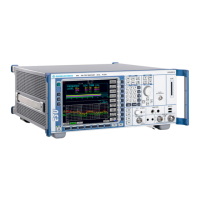R&S ESU Maintenance and Instrument Interfaces
Instrument Interfaces
8.8 Operating Manual 1302.6163.12 - 03
• GND
Interface ground, connected to instrument ground
• DSR (Data Set Ready)
Input, active LOW,
Indicates that the remote station is ready to receive data.
• RTS (Request To Send)
Output, active LOW.
Indicates that the local terminal wants to transmit data.
• CTS (Clear To Send)
Input, active LOW.
Used to tell the local terminal that the remote station is ready to receive data.
• RI (Ring Indicator)
Not used in R&S ESU.
Input, active LOW.
Used by a modem to indicate that a remote station wants to establish a
connection.
8.3.3.3 Transmission Parameters
To ensure error-free data transmission, the parameters of the instrument and the
controller must have the same settings. The parameters are defined in the SETUP-
GENERAL SETUP menu.
Example
Transmission of character 'A' (41 hex) in 7-bit ASCII code, with even parity and 2
stop bits:
Transmission rate
(baud rate)
The following transmission rates can be set in the
instrument: 110, 300, 600, 1200, 2400, 4800, 9600, 19200,
38400, 57600, 115200, 138000.
Data bits Data transmission is in 7- or 8-bit ASCII code. The first bit
transmitted is the LSB (least significant bit).
Start bit Each data byte starts with a start bit. The falling edge of the
start bit indicates the beginning of the data byte.
Parity bit In order to detect errors, a parity bit may be transmitted. No
parity, even parity or odd parity may be selected. In addition,
the parity bit can be set to logic '0' or to logic '1'.
Stop bits The transmission of a data byte is terminated by 1, 1,5 or 2
stop bits.
03
04
05
06 07
08
09
10
11
02
01
Bit 01
Start bit
Bit 02...08
Data bits
Bit 09
Parity bit
Bit 10...11
Stop bits

